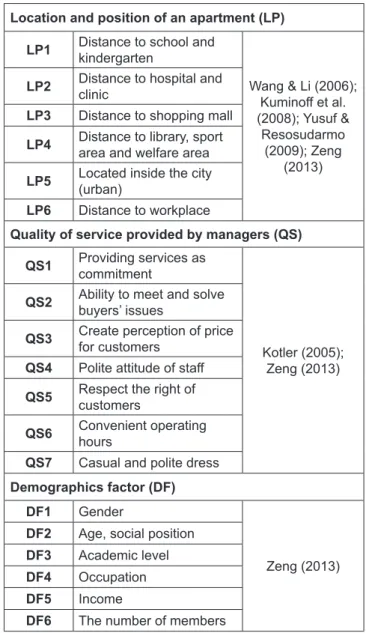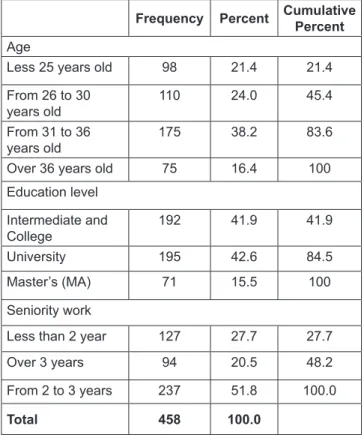Print ISSN: 2288-4637 / Online ISSN 2288-4645 doi:10.13106/jafeb.2020.vol7.no5.185
1
First Author. PhD Candidate, The National Economics University, Vietnam / VITC Joint Stock Company / Chairman, Hanoi Real Estate Club, Vietnam. Email: cuong333hanoi@gmail.com
2
Corresponding Author. Lecturer, Department of Accounting, University of Labor and Social Affairs, Vietnam [Postal Address:
No. 43, Tran Duy Hung Road, Cau Giay District, Hanoi, 113000, Vietnam] Email: taiketoanquocte@gmail.com
© Copyright: The Author(s)
This is an Open Access article distributed under the terms of the Creative Commons
Attribution Non-Commercial License (http://Creativecommons.org/licenses/by-nc/4.0/)
which permits unrestricted noncommercial use, distribution, and reproduction in any
medium, provided the original work is properly cited.
Factors Influencing the Perception of the Selling Price of Luxury Apartments
Huu Cuong NGUYEN
1, Duc Tai DO
2
Received: March 03, 2020 Revised: March 15, 2020 Accepted: April 03, 2020
Abstract
The study aims to identify and measure factors affecting the perception of the selling price of luxury apartments in Hanoi. We conducted a questionnaire consisting of 29 observation variables with a 5-point Likert scale. Independent variables were measured from 1 “without effect” to 5 “strongly”. Based on the desk review and results of interviews, a total of 500 questionnaires were sent to research participants for collection; 458 of them met standard and were subject to be analyzed. This study employs Cronbach’s Alpha test, and regression model.
The results of Exploratory Factor Analysis (EFA) and Multiple Regression Analysis (MRA) identify five main determinants influencing the perception of the selling price of luxury apartments in Hanoi, including Physical characteristics of a luxury apartment (PC); Location and position of an apartment (LP); Surrounding Area (SA); Quality of service provided by managers; (QS) and Demographics factor (DF).
Based on the findings, some recommendations have been proposed to help the firm leaders design appropriate personnel policies for creating better price satisfaction for customers in the future. On this basis, the authors propose a number of recommendations to improve the quality of luxury apartments, thereby contributing to the development of the market for luxury apartments in Hanoi.
Keywords : Selling Price, Selling Price Perception, Luxury Apartments, Real Estate, Hanoi, Vietnam JEL Classification Code: G12, G13, G14, L80, L85
1. Introduction
The real estate market plays an important role in the economy of all countries in the world. Not only does it ensure the construction of the necessary infrastructure for working and living condition, this market also has a strong impact on the development of the economy. The selling price of luxury apartment segment (LAS) is an indication of economic growth, rapid urbanization and LAS is becoming preference of high-income earners segment with high quality of life.
The demand for housing in big cities is increasing and diverse due to many reasons. Firstly, the population is growing faster and the trend of migration from suburban areas to big cities like Hanoi and Ho Chi Minh City are increasing. Secondly, the younger generation now prefers separating from their parents. The demographic division, the need to move out when getting married, and the trend of moving to the center, lead to high demand for housing while the city land bank is increasingly tight. Third, expatriates, businesses and foreign organizations are returning home for working, doing business and living in Hanoi and Ho Chi Minh City. At the same time, many new urban areas and many industrial zones along the inner city need a large amount of concentrated labor. Moreover, the demand for land for housing and public services are increasingly urgent.
Housing is not only a place for people to live, but affects
their morale, quality of life and economic development
also. Urban areas with adequate conditions and amenities
will directly or indirectly help people develop and improve
their quality of life. Those who strive to own and prioritize
housing quality have many opportunities to access high
quality services such as education and health.


